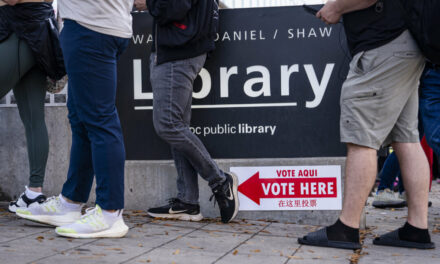We support our Publishers and Content Creators. You can view this story on their website by CLICKING HERE.
Voters in 10 states showed they still have mixed feelings on the controversial procedure.
Abortion-related ballot measures have been popular following the U.S. Supreme Court’s Dobbs decision to overturn the federal right to abortion and send legislation on the procedure to the states.
The ruling set off a domino effect as state after state moved to either tighten restrictions on the procedure or strengthen protections for access.
By the 2024 general election, seven out of seven states had sided with abortion advocates at the ballot box. As voters in California, Michigan, Ohio, and Vermont approved measures to cement abortion as a right, those in Kansas and Kentucky rejected initiatives to limit abortion access. Meanwhile, a referendum to require medical care for infants born alive during botched abortions failed in Montana.
As voters in 10 more states decided on abortion-related ballot measures on Nov. 5, they showed that the ideological divide on the procedure still runs deep.
Arizona
Arizona voters had to decide whether to enshrine abortion as a constitutional right.
Abortion is currently legal in Arizona through 15 weeks of pregnancy, following the recent repeal of an 1864 law that banned all abortions except those performed to save the life of the mother.
Proposition 139, a citizen-led initiative, sought to establish a “fundamental right to abortion” through fetal viability, and up until birth when deemed necessary “to protect the life or health of the pregnant individual.”
Fetal viability is typically recognized at around 22–24 weeks of pregnancy, though premature babies have survived with medical assistance as early as 19 weeks.
The amendment also barred the state from penalizing those who assist an individual in obtaining an abortion.
The proposition passed with roughly 62 percent of the vote.
Colorado
Colorado’s Amendment 79 asked voters to establish a constitutional right to abortion and repeal a 1984 amendment that prohibits public funding of the procedure.
Abortion is already accessible throughout the entirety of pregnancy in Colorado. The state does not impose any limits on the procedure’s legality, though there is a parental notification requirement for minors under 18, which can be waived by a judge.
Colorado requires a 55 percent majority to add language to the state’s constitution. The amendment surpassed that threshold, passing with 61 percent of the vote.
Florida
Florida’s abortion amendment, Amendment 4, sought to nullify the state’s six-week abortion law, which includes exceptions for rape, incest, human trafficking, fatal fetal abnormalities, and medical emergencies.
The amendment aimed to establish a constitutional right to abortion through fetal viability or “when necessary to protect the patient’s health, as determined by the patient’s health care provider.”
Florida Gov. Ron DeSantis speaks out against Amendment 4, which would expand access to abortion, during a news conference with Florida Physicians Against Amendment 4, in Coral Gables, Fla., on Oct. 21, 2024. Lynne Sladky/AP Photo
Although a majority (57 percent) of voters supported the amendment, it fell short of the 60 percent threshold required to pass, making Florida voters the first in the nation to reject an abortion-related ballot measure in the post-Dobbs era.
Amendment 4 was fiercely contested by Florida’s Republican leadership, who argued that it was deceptively written to trick voters.
The petition’s circulators also remain embroiled in a fraud investigation amid allegations that they forged signatures to secure the measure’s spot on the ballot. The state’s Office of Election Crimes and Security has referred 60 circulators to law enforcement for further investigation.
Maryland
A legislatively referred constitutional amendment in Maryland sought to create a “fundamental right to reproductive freedom” to include “the ability to make and effectuate decisions to prevent, continue, or end the individual’s pregnancy.”
At present, abortion is legal in Maryland through fetal viability, and illegal after that, with exceptions for the mother’s life or health.
A simple majority was needed to adopt the new law. It passed with an overwhelming 74 percent of the vote.
Missouri
Missouri’s Amendment 3 was another initiative that aimed to enshrine a right to “reproductive freedom,” defined as the right to “make and carry out decisions about all matters relating to reproductive health care.”
Those matters were to include—but not be limited to—abortion, prenatal care, childbirth, postpartum care, birth control, miscarriage care, and “respectful birthing conditions.” Regulation of abortion would have been permitted after fetal viability, except in cases where the procedure was deemed necessary to protect the mother’s life or physical or mental health.
Receiving 52 percent of the vote, the measure just exceeded the 50 percent majority needed to pass.
Montana
The 2024 general election marked the second time Montanans have voted on an abortion-related issue since the Supreme Court’s Dobbs decision.
While voters rejected the proposed “Born Alive” referendum in 2022, they were asked this time to decide whether the state’s constitution should provide “a right to make and carry out decisions about one’s own pregnancy, including the right to abortion.”
Montana already recognizes a right to abortion thanks to a 1999 Montana Supreme Court ruling that found the procedure was covered by the state’s right to privacy.
Nebraska
Two competing abortion amendments went before Nebraska voters after the state’s Supreme Court approved both for the ballot.
The state currently allows abortion through 12 weeks or until the second trimester of pregnancy.
Initiative 434 will codify those restrictions in the state’s constitution after passing at 55 percent. It declares that “unborn children shall be protected from abortion in the second and third trimesters” of pregnancy, except in cases involving rape, incest, or medical emergencies.
Initiative 439, the “Protect the Right to Abortion” amendment, sought to establish that “all persons shall have a fundamental right to abortion until fetal viability,” or if considered necessary, to protect the mother’s health or life. That amendment was rejected by a 51 percent majority.
Nevada
Nevada currently allows abortion within the first 24 weeks of pregnancy. It is also allowed after that threshold when it is deemed necessary to preserve the mother’s life or health.
Question 6 aimed to modify that by enshrining in the state’s constitution a right to abortion until fetal viability and prohibiting state regulation of the procedure within that period, save for in situations involving a “compelling state interest achieved by the least restrictive means.”
While voters ultimately passed the amendment with 63 percent support, they will need to approve it again in 2026 for it to be adopted.
New York
New Yorkers were asked to decide on an abortion-related measure that did not expressly mention the procedure.
The state already allows abortion through fetal viability and when deemed necessary to protect the mother’s life or health.
Proposal 1, a legislatively referred constitutional amendment, sought to prohibit the denial of a person’s civil rights based on “pregnancy, pregnancy outcomes, and reproductive health care and autonomy,” among a litany of other factors and traits.
The amendment passed easily with 62 percent of the vote.
South Dakota
South Dakota’s Constitutional Amendment G was perhaps the most complex of all the abortion amendments dotting ballots this Election Day.
The amendment stipulated that the state could not regulate abortion within the first trimester of pregnancy. In the second trimester, regulation would be allowed “only in ways that are reasonably related to the physical health of the pregnant woman.” And in the third trimester, abortion could be prohibited except when deemed necessary to preserve the woman’s life or health.
The effect would be legal abortion through 28 weeks—past the point of fetal viability—and until birth if considered medically necessary.
The proposal marked a stark contrast with South Dakota’s current law, which prohibits abortion in all circumstances except to save the mother’s life.
The new measure was rejected, earning 40 percent of the vote.

 Conservative
Conservative  Search
Search Trending
Trending Current News
Current News 







